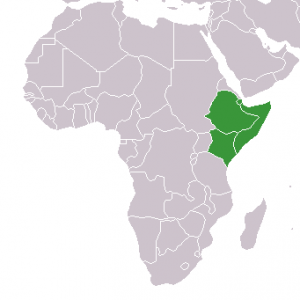The polio outbreak in the Horn of Africa that began in Somalia in April 2013 continues into the summer of 2014 as Somalia reports three additional cases of wild poliovirus 1 (WPV 1) during the past week from Mudug.

Public domain image/ Lexicon at the English Wikipedia project
This brings the total of cases from the Horn of Africa to 5 (one WPV1 in Ethiopia and four WPV1 in Somalia) in 2014. In 2013, the Horn of Africa reported 217 cases, with Somalia accounting for 194 cases.
The Global Polio Eradication Initiative reports the cases are caused by virus closely related to that previously detected in Mogadishu in July 2013. No cases have been detected in the epicentre of the outbreak, in Mogadishu, Banadir region, since 19 July 2013.
In addition, Mudug is a remote area with challenging conditions to plan and implement immunization campaigns and with hard-to-reach, under-served nomadic populations. While the proportion of children with three or more doses of oral polio vaccine has risen since 2012, it is still below 80%. None of the children paralyzed in Mudug had ever been vaccinated against polio.
Elsewhere, two of the three endemic countries reported new polio cases in the past week. In Afghanistan, one new case of wild poliovirus type 1 (WPV1) was reported in the past week, from Khost Province. The child is from a Pakistani family from polio-endemic North Waziristan who fled to Afghanistan to escape conflict at home. Already ill with fever when leaving Pakistan, the child developed paralysis on 16 June, 2014, in Khost province, one day after arrival from N. Waziristan. Including this most recent case, Afghanistan has reported eight polio cases to date in 2014, compared to three at this time in 2013.
In Pakistan, four new wild poliovirus type 1 (WPV1) cases were reported in the past week, bringing the country’s total case count to 94. The most recent cases had onset of paralysis on 24 June, one from Khyber Agency of the Federally Administered Tribal Areas (FATA), one from Peshawar in Khyber Pakhtunkhwa province and one from Sanghar in Sindh province.
The global total polio cases for 2014 stands at 123. For more infectious disease news and information, visit and “like” the Infectious Disease News Facebook page
The World Health Organization (WHO) reported an “Update on polio in Equatorial Guinea” Thursday, which goes as follows:
As of 16 July 2014, Equatorial Guinea has reported a total of 5 wild poliovirus type 1 (WPV1) cases, with onset of paralysis between 28 January 2014 (first case) and 3 May 2014 (most recent case). Genetic sequencing indicated that the cases are linked to the ongoing outbreak in Cameroon.
A national emergency action plan to respond to the polio outbreak was developed by the Ministry of Health and polio partner agencies and is being implemented. Three nationwide campaigns with bivalent oral polio vaccine (bOPV) have already been conducted in the country – two campaigns targeting children under 15 years old in April 2014 and early May 2014, and one in late May 2014 targeting children under 5 years old. Two nationwide bOPV campaigns are planned for mid-July 2014 and mid-August 2014; the July 2014 round will target the entire population, and the August 2014 round will target children under 15 years old.
As noted in the Disease Outbreak News update published on 25 June 2014, Brazil reported on 18 June 2014 that WPV1 had been detected in a sewage sample collected in March 2014 at Viracopos International Airport in Sao Paulo state, with genetic sequencing indicating that this virus is most closely related to the virus currently circulating in Equatorial Guinea. No further samples have tested positive to date in Brazil, nor have any paralytic polio cases been detected there.
According to the International Health Regulations (IHR) Temporary Recommendations issued by the Director-General of WHO on 5 May 2014, Equatorial Guinea is considered as a polio exporting country.

